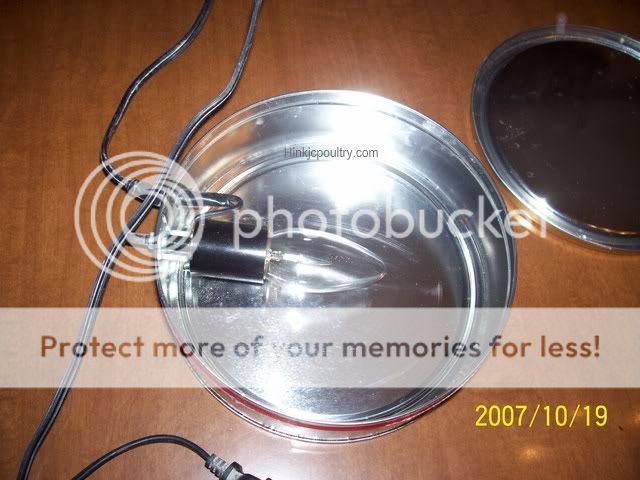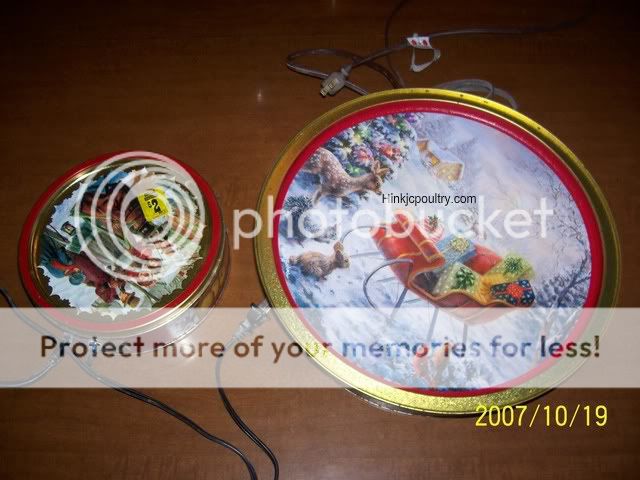Navigation
Install the app
How to install the app on iOS
Follow along with the video below to see how to install our site as a web app on your home screen.
Note: This feature may not be available in some browsers.
More options
You are using an out of date browser. It may not display this or other websites correctly.
You should upgrade or use an alternative browser.
You should upgrade or use an alternative browser.
Cookie Tin water heater
- Thread starter hinkjc
- Start date
Just made mine to, can't be to ready.
- Mar 24, 2013
- 703
- 264
- 276
Just made mine to, can't be to ready.
I just need to figure out how to keep the waterer on top of the tin and not have it tip over, drip into the electric of the tin or anything else.
Suggestions anyone??????
I was going thru my old pics and found these and thought others may find them useful. They are small and large size cookie tins. The small ones (approx 6 inches round) work well for 1 gallon plastic waterers. The Larger one works well for the wider mouth 1 gallon waterers and 2-3 gallon waterers. I use a 25 or 40 watt bulb, depending on temps. Typically 25 watt is sufficient.


Jody
- Nov 5, 2013
- 11
- 0
- 56
Our chicken water froze a couple of weeks ago and I built a cookie tin heater in no time.
The construction would have been quicker but I used stuff I had in the garage to build the Cookie tin heater without buying anything.
I used an old cookie tin, parts from a broken exterior motion spot light, an old extension cord for Christmas lights, a couple of wire nuts and a block of wood.
Pre-drill holes into the wood for wood screws, and a hole for the wire. The wood is a strip of 1x2 and its purpose is to make the tin stronger to support the light mounting.
An old light socket from and a failed out door motion light is bolted to the wood and wired to the old extension cord with wire nuts and covered with a liberal amount of electrical tape.
A 25 watt bulb does the job.
Warm days and cold nights allow the use of a timer to save energy.

Cookie tin with 3 bricks for insulation and support. Note metal straps screwed to block and holding wire from being accidentally pulled loose.

Parts from old outdoor motion light. Socket had to be repaired slowing down assembly. Block of 1 x 2 holds light mount.

Small block of wood with high temp silicone (from my tool box) to support socket and bulb.

Three bricks on level ground provide insulation and almost level support.
The construction would have been quicker but I used stuff I had in the garage to build the Cookie tin heater without buying anything.
I used an old cookie tin, parts from a broken exterior motion spot light, an old extension cord for Christmas lights, a couple of wire nuts and a block of wood.
Pre-drill holes into the wood for wood screws, and a hole for the wire. The wood is a strip of 1x2 and its purpose is to make the tin stronger to support the light mounting.
An old light socket from and a failed out door motion light is bolted to the wood and wired to the old extension cord with wire nuts and covered with a liberal amount of electrical tape.
A 25 watt bulb does the job.
Warm days and cold nights allow the use of a timer to save energy.
Cookie tin with 3 bricks for insulation and support. Note metal straps screwed to block and holding wire from being accidentally pulled loose.
Parts from old outdoor motion light. Socket had to be repaired slowing down assembly. Block of 1 x 2 holds light mount.
Small block of wood with high temp silicone (from my tool box) to support socket and bulb.
Three bricks on level ground provide insulation and almost level support.
Last edited:
Yep, The cookie tin heater is the bomb. Mine is still in operation 4yrs on now. Check out the link below. Instead of a timer, use a ThermoCube. Then the fount warmer only comes on when it needs to.Our chicken water froze a couple of weeks ago and I built a cookie tin heater in no time.
The construction would have been quicker but I used stuff I had in the garage to build the Cookie tin heater without buying anything.
I used an old cookie tin, parts from a broken exterior motion spot light, an old extension cord for Christmas lights, a couple of wire nuts and a block of wood.
Pre-drill holes into the wood for wood screws, and a hole for the wire. The wood is a strip of 1x2 and its purpose is to make the tin stronger to support the light mounting.
An old light socket from and a failed out door motion light is bolted to the wood and wired to the old extension cord with wire nuts and covered with a liberal amount of electrical tape.
A 25 watt bulb does the job.
Warm days and cold nights allow the use of a timer to save energy.
http://www.amazon.com/Farm-Innovators-TC-3-Thermostatically-Controlled/dp/B0006U2HD2
- Apr 1, 2013
- 4
- 0
- 7
Last edited:
This worked great for my chickens until we had a cold streak where the high was about 5 degrees or less. For those days I hauled out boiling water in the morning and then they would stay thawed for most of the day with the tin water heater underneath.
SrBoyle, what wattage is your bulb, and is your coop insulated with good draft control? I had had doubts about my hanging waterer staying in a liquid state, but it did, even to 5 F. I was very surprised and pleased. I built a wood-and-cement-board water heater in 2012. I use a 60-watt incandescent in it. Since the wood-and-cement-board surround act like an insulator, heat is mostly allowed to escape through the top and, to a lesser extent, the bottom. Since its heat is more directed than a metal can, more BTUs are acting on the waterer. I have elevated the heater on wood blocks for a closer proximity to the waterer, but with adequate space, approx. 12 inches, for the chickens to access the nipples in the bottom. The circuit is controlled by a ThermoCube.This worked great for my chickens until we had a cold streak where the high was about 5 degrees or less. For those days I hauled out boiling water in the morning and then they would stay thawed for most of the day with the tin water heater underneath.
It occurs to me that two cookie tins, one big, the other smaller, could be used one inside the other with insulation in the space. That also should transmit more BTUs upward with fewer BTUs lost laterally.
New posts New threads Active threads
-
Threads with more replies in the last 15 days
-
-
-
-
Chicken Butt Emergency ‼️ Please Help!
- Started by urlocalcrazychickenlady
- Replies: 71
-
Ended BYC Poultry Caption Contest 11-28-25 Pic by Ponypoor
- Started by TwoCrows
- Replies: 62
-
×




